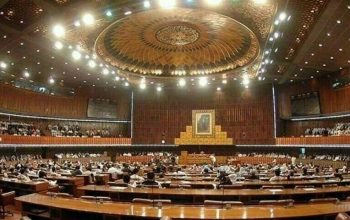As torrential rains continue to batter the country, passengers remained stranded after heavy downpours spawned extreme flooding and a landslide in the Karakoram Highway (KKH), leaving parts of the arterial passage blocked and creating punishing travel conditions.
The landslide forced the closure of the thoroughfare between Khyber-Pakhtunkhwa’s Upper Kohistan and Chilas in Gilgit-Baltistan’s Diamer district, officials said, adding that the surface communication with China was also disrupted due to landslides near Khunjerab Zero Point.
The incident resulted in snarled traffic with reportedly hundreds of people trapped on swamped roads as efforts to restore the artery failed. Meanwhile, the ground that is still saturated from the previous rains is potentially creating conditions for more mudslides and flooding ahead of anticipated heavy rains expected to be unleashed on July 31.
According to Ghulam Abbas, the National Highway Authority’s (NHA) deputy director for Shangla and Kohistan in K-P, the road was blocked at nine different points between Diamer and Kohistan.
Read more: Landslides block Kaghan Highway
There is a large blockade of around 500 metres in length and 7m in height in Kaigah, he said, adding that the work to clear the rubble and debris was under way, expecting that all blockades would be removed by Monday night.
Fatalities
Meanwhile, one person was killed while five others were reported missing after a passenger van plunged into the Indus River in Gilgit.
A van carrying tourists from Rajanpur, Punjab lost control due to the driver’s error and subsequently plunged into the Indus River, he added.
Rescue teams arrived at the scene and recovered mobile phones, a gas cylinder, and men’s shoes from the spot.
Meanwhile, at least six people were killed in rain-related incidents across Balochistan on Monday. The Provincial Disaster Management Authority declared an emergency in the areas hit by rains and floods.
The monsoon rains have been ongoing in Balochistan for the past week, in which most of the rains were recorded in the districts of Sahabpur, Lasbela, Bolan, Harnai, Sorab and Zhob.
At least two people were swept away in the floodwaters in Naseerabad district. The rescue workers retrieved the bodies in the Harnai, Lasbela and Sohbatpur districts of Balochistan.
The PDMA has stepped up efforts to reach all the rain-affected people across the province.
PDMA Director Faisal Panezai informed that a letter was sent to the authorities to impose Section 144 at all picnic points, and along with this, food and necessary supplies for over 300 people have been delivered to the deputy commissioners of all districts.
More rains
Meanwhile, in a briefing on rainfall in the last 24 hours and the upcoming monsoon spell, the PMD DG informed that the next monsoon spell was expected to bring heavy rains in the upper parts of the country from July 31 to Aug 6, triggering urban flooding from major cities, flash flooding, and landslides in hilly regions.
He said major reservoirs, including Tarbela and Mangla, were nearly full at 79% and 74%, respectively, adding that two Indian dams – Pong and Thein – were also almost flowing to their brim, creating a possibility of flood flow from India into Indus River, which may affect Lahore adversely.
The FFC informed that all major rivers are currently within normal limits.
Separately, in a statement on Monday, the Pakistan Meteorological Department said that monsoon currents were continuously penetrating the country from the Bay of Bengal and the Arabian Sea.
“A fresh westerly wave is also likely to enter upper parts of the country from July 26,” it warned, saying the heavy rains could cause flash flooding in Balochistan and hill torrents of Dera Ghazi Khan on July 25 and 26 and from July 26 to 28 in AJK, Dir, Swat, Kohistan, Shangla, Buner, Manshera, Abbottabad and Rawalpindi/Islamabad.
Also read: Pakistan braces for floods, landslides as PMD warns of ‘significant weather event’
It warned of possible urban flooding as well in the low-lying areas of Sukkur, Larkana, Qamber Shahdad Kot, Noushero Feroze and Dadu on July 25 and 26 and the low-lying areas of Islamabad/Rawalpindi, Peshawar, Gujranwala, Lahore, Faisalabad from July 25 to 28.
“[Heavy rain] may trigger landslides in the vulnerable areas of Murree, Galliyat, AJK, G-B and hilly areas of K-P during the wet period,” the statement cautioned.
Authorities take stock
In view of the deteriorating situation, relevant authorities whirred into action to ensure the implementation of preventive and rescue measures.
Acting NDMA Chairman Brigadier Naiknam Muhammad Baig presided over a special National Emergencies Operations Centre (NEOC) session with key stakeholders to take stock of the current monsoon situation.
He reviewed the restoration of roads and bridges, monsoon-related incidents and rescue and relief operations in parts of the country, including Chitral, G-B and AJK in the past two days.
133 lives lost
Meanwhile, at least 133 people were reported to have been killed while 215 injured in rain-related incidents since the start of monsoon on June 25 as torrential rains wreaked havoc across the country, mainly in Punjab and K-P, according to a report issued by the National Disaster Management Authority (NDMA).
Every year, between June and September, monsoon winds bring rains to South Asia, accounting for 70% to 80% of the region's annual rainfall.
According to a breakdown provided by the NDMA, 65 deaths were reported in Punjab, 35 in K-P, 11 in Islamabad Capital Territory (ICT), 10 in Sindh, six in Balochistan, five in AJK and one in G-B.
The majority of the deaths were mainly due to electrocution and building collapses, official data showed.
Read the full story at the express tribune website.


